
Charms with Auspicious Inscriptions -- Good Fortune, Wealth, Longevity, Honor, Sons and Official Rank
The Chinese have traditionally had a very strong belief in the efficacy of charms which could bring good luck to oneself and family, and of amulets to dispel evil influences.
For this reason, the majority of old Chinese charms include four or eight character inscriptions (legends) that wish for good luck, good fortune, wealth, longevity, a large family, and success in the imperial examination system resulting in promotion to an official government position.
A number of these "good luck" charms are displayed and explained in detail below.
Success in the Imperial
Examination System
In ancient China, being
successful in the imperial examination system would result
in being appointed to an official government position
which ensured a comfortable life of wealth and
influence. The examination system existed for
approximately 1300 years and finally ended just before the
collapse of the Qing (Ch'ing) Dynasty in 1911.
A successful candidate would also bring honor to his entire extended family. Therefore, it was very common for Chinese parents to acquire charms in the belief that they could assist in having their son, or sons, meet with success in the examinations.
In addition to an auspicious inscription (legend) written in Chinese characters expressing hope for success, these charms also relied on traditional Chinese symbols to make a similar statement using pictures and visual puns.
Examples of such charms are presented in the section below and are accompanied by an explanation of the hidden meaning of their symbols and pictures.
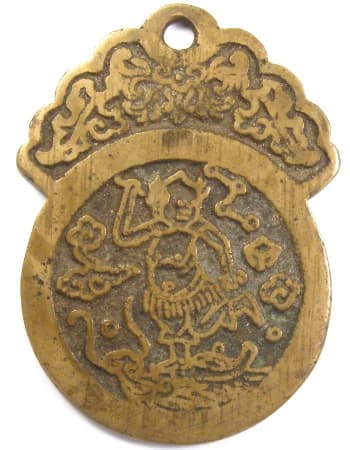 This
pendant charm displays Kuixing (魁
星) who is known as the God of Examinations or
the Star of Literature. He was believed to have been
influential in assisting candidates to pass the imperial
civil service examination.
This
pendant charm displays Kuixing (魁
星) who is known as the God of Examinations or
the Star of Literature. He was believed to have been
influential in assisting candidates to pass the imperial
civil service examination.
He is frequently depicted as an ugly man with short horns. In his right hand he holds a writing brush. Many times he is shown holding a scholar's hat or a peck measure in his left hand.
The short horns on his head represent "success" by alluding to the analogy of the carp fish jumping over the mythical Dragon Gate and becoming a dragon. (Please see Fish Charms for more information.)
As is the case here, Kuixing is usually shown standing on one leg on the head of a very large fish or a mythical turtle known as the ao (鳌). The ancient Chinese believed that the earth was supported by this very large sea turtle.
Beginning in the Tang and Song dynasties, the palaces of Chinese emperors had stone steps which included a carving of an ao. The list of successful candidates in the examinations were posted in front of these steps and the person who placed first in the examination had the honor to stand on the head of the ao.
The Chinese expression "to stand alone on the head of the ao" (du zhan ao tou 独占鳌头), therefore, came to signify being first on the list of successful candidates.
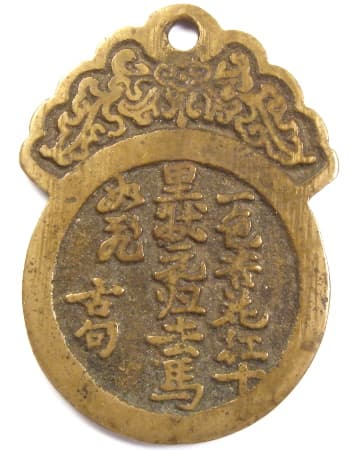 The reverse side has
what the charm proclaims is an "ancient sentence" (gu ju 古句).
The reverse side has
what the charm proclaims is an "ancient sentence" (gu ju 古句).
In reality, this ancient saying or poem is attributed to Song Zi Jing (Sung Tzu-ching 宋子京) who lived during the years 998-1061 of the Song Dynasty and was a celebrated writer and the head of the Board of Works.
The sentence is written in vertical columns, top to bottom, starting at the right, and reads as follows:
一色杏花红十里壮元归去马如飞
yi se xing hua hong shi li zhuang yuan gui qu ma ru fei
This sentence can be interpreted to mean that a scholar who had just attained the honor of coming in first in the final Hanlin examination sees an expansive field of blossoming red apricot flowers which prompts him to make his horse gallop even faster on his way home.
The blooming apricots is an allusion to the very first celebration honoring successful graduates of the final examination which was allegedly held in an apricot grove.
This charm has a length of 56 mm, a maximum width of 41 mm, and a weight of 20.6 grams.
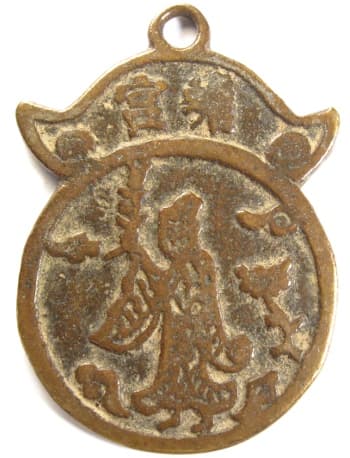 This is
another charm concerned with success in the imperial
examinations which to more fully understand requires
knowing a little about Chinese myth and the moon.
This is
another charm concerned with success in the imperial
examinations which to more fully understand requires
knowing a little about Chinese myth and the moon.
The charm shows an elegantly dressed female carrying in her right hand a branch from the cassia tree (gui shu 桂树), sometimes incorrectly referred to as the cinnamon tree. At the very top of the charm are two Chinese characters which read right to left as chan gong (蟾宫). Chan (蟾) actually means "toad" and gong (宫) means "palace" so the expression means "toad palace".
What is the "toad palace" (chan gong 蟾宫)?
The reference is to an ancient story dating back to the dawn of Chinese history and the reign of the "sage-king" Emperor Yao (尧) (2358-2258 BC).
Houyi (后羿) was an expert archer who saved the earth from burning by shooting down nine of the ten "suns" which were represented by "three-legged birds" (san zu wu 三足乌) called "sun birds".
As a reward, Houyi received a pill (or elixir) of immortality from the Queen Mother of the West (xiwangmu 西王母) .
Houyi's wife Chang'e (嫦娥) found the pill (or elixir) of immortality which Houyi had hidden, ate it, and then floated to the moon where she is destined to live for eternity.
Chang'e's companion on the moon is the "Moon Hare" or "Jade Rabbit" (yu tu 玉兔) who, next to a large and magical cassia (cinnamon) tree (gui shu 桂树), works eternally pounding cassia leaves, flowers and bark with mortar and pestle trying to recreate the pill of immortality so that Chang'e can float back to earth to reunite with her husband.
In the meantime, Chang'e, also known as the "Moon Goddess", lives is a cold palace (guang han gong 广寒宫) built among cassia trees.
Some versions of the story describe that the Queen Mother of the West punished Chang'e for stealing the pill (or elixir) by transforming her into a toad (chanchu 蟾蜍). Over the centuries that followed, the Chinese gradually associated the "toad" with the "moon" and eventually the expression "toad palace" came to simply refer to the "moon".
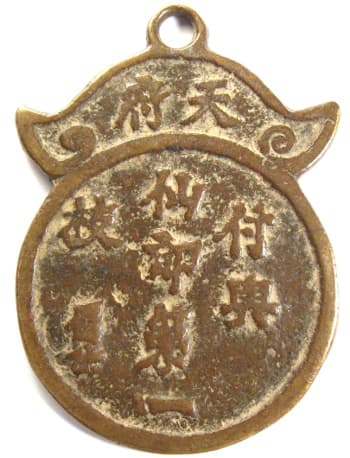 The reverse side of the charm has two
Chinese characters at the top of the canopy which are read
right to left as tian
fu (天府) meaning "heavenly palace".
The reverse side of the charm has two
Chinese characters at the top of the canopy which are read
right to left as tian
fu (天府) meaning "heavenly palace".
The main body of the charm has an inscription written in vertical columns beginning at the right as follows:
付与仙朗第一枝 (fu yu xian lang di yi zhi)
The inscription literally translates as "to give to" (fu yu 付与) an "immortal young gentleman" (xian lang 仙朗) "the first branch" (di yi zhi 第 一枝).
The "immortality" alludes to the story of Houyi and Chang'e mentioned above but in this case is also referring the "eternal" fame a man can achieve through his accomplishments.
To understand the meaning of the inscription one must understand that the "branch" in the inscription is a branch from the "cassia" (gui 桂) tree, which happens to have exactly the same pronunciation as the word for "high rank" (gui 贵).
"To be given the first branch" (di yi zhi 第 一枝) therefore has the hidden or implied meaning of "to be given the first rank" which comes with the distinction of achieving success in the imperial or Hanlin examination.
The Chinese have the expression deng ke (登科) which means to be announced as a successful candidate in the examination system.
A similar expression is "to pluck" or "break off" the cassia (zhe gui 折桂) which means to "grasp" a "high government office or rank" (gui 贵) or, more specifically, to obtain the third degree known as the jin shi (进士).
The most literary expression with this same meaning, however, is chan gong zhe gui (蟾宫折桂) meaning "to pluck the cassia from the toad palace".
Furthermore, the register or tablet upon which the names of the successful examination candidates are written is called the "cassia register" (guiji 桂籍).
The charm therefore illustrates a young woman or wife or, perhaps even Chang'e herself, giving a cassia branch which is an allegory referring to giving a high government office as a result of a person's success in the imperial examinations.
But this charm can also be interpreted on another level.
There is a similar expression of xiao deng ke (小登科). "Xiao" means "little" and in this case the deng ke does not refer to an announcement of success in the examinations but rather to marriage!
The charm can thus also be interpreted as celebrating another major achievement in a man's life because marriage was a first step in fulfilling the Confucian responsibilites of producing children to continue the ancestral lineage and to carry out ancestor worship.
Finally, the two Chinese characters written vertically on the left side of the charm read mei gong (眉公). Mei Gong was the "assumed" or "style" (hao 号) name of Chen Ji Ru (陈继儒) who lived during the years 1558-1639 and was a very famous calligrapher of the Ming Dynasty (1368-1644).
The inscription on the charm is therefore attributed to Chen Ji Ru.
This charm has a length of 65.2 mm and a maximum width of 49 mm.
A successful candidate would also bring honor to his entire extended family. Therefore, it was very common for Chinese parents to acquire charms in the belief that they could assist in having their son, or sons, meet with success in the examinations.
In addition to an auspicious inscription (legend) written in Chinese characters expressing hope for success, these charms also relied on traditional Chinese symbols to make a similar statement using pictures and visual puns.
Examples of such charms are presented in the section below and are accompanied by an explanation of the hidden meaning of their symbols and pictures.
 This
pendant charm displays Kuixing (魁
星) who is known as the God of Examinations or
the Star of Literature. He was believed to have been
influential in assisting candidates to pass the imperial
civil service examination.
This
pendant charm displays Kuixing (魁
星) who is known as the God of Examinations or
the Star of Literature. He was believed to have been
influential in assisting candidates to pass the imperial
civil service examination.He is frequently depicted as an ugly man with short horns. In his right hand he holds a writing brush. Many times he is shown holding a scholar's hat or a peck measure in his left hand.
The short horns on his head represent "success" by alluding to the analogy of the carp fish jumping over the mythical Dragon Gate and becoming a dragon. (Please see Fish Charms for more information.)
As is the case here, Kuixing is usually shown standing on one leg on the head of a very large fish or a mythical turtle known as the ao (鳌). The ancient Chinese believed that the earth was supported by this very large sea turtle.
Beginning in the Tang and Song dynasties, the palaces of Chinese emperors had stone steps which included a carving of an ao. The list of successful candidates in the examinations were posted in front of these steps and the person who placed first in the examination had the honor to stand on the head of the ao.
The Chinese expression "to stand alone on the head of the ao" (du zhan ao tou 独占鳌头), therefore, came to signify being first on the list of successful candidates.
 The reverse side has
what the charm proclaims is an "ancient sentence" (gu ju 古句).
The reverse side has
what the charm proclaims is an "ancient sentence" (gu ju 古句).In reality, this ancient saying or poem is attributed to Song Zi Jing (Sung Tzu-ching 宋子京) who lived during the years 998-1061 of the Song Dynasty and was a celebrated writer and the head of the Board of Works.
The sentence is written in vertical columns, top to bottom, starting at the right, and reads as follows:
一色杏花红十里壮元归去马如飞
yi se xing hua hong shi li zhuang yuan gui qu ma ru fei
This sentence can be interpreted to mean that a scholar who had just attained the honor of coming in first in the final Hanlin examination sees an expansive field of blossoming red apricot flowers which prompts him to make his horse gallop even faster on his way home.
The blooming apricots is an allusion to the very first celebration honoring successful graduates of the final examination which was allegedly held in an apricot grove.
This charm has a length of 56 mm, a maximum width of 41 mm, and a weight of 20.6 grams.
 This is
another charm concerned with success in the imperial
examinations which to more fully understand requires
knowing a little about Chinese myth and the moon.
This is
another charm concerned with success in the imperial
examinations which to more fully understand requires
knowing a little about Chinese myth and the moon.The charm shows an elegantly dressed female carrying in her right hand a branch from the cassia tree (gui shu 桂树), sometimes incorrectly referred to as the cinnamon tree. At the very top of the charm are two Chinese characters which read right to left as chan gong (蟾宫). Chan (蟾) actually means "toad" and gong (宫) means "palace" so the expression means "toad palace".
What is the "toad palace" (chan gong 蟾宫)?
The reference is to an ancient story dating back to the dawn of Chinese history and the reign of the "sage-king" Emperor Yao (尧) (2358-2258 BC).
Houyi (后羿) was an expert archer who saved the earth from burning by shooting down nine of the ten "suns" which were represented by "three-legged birds" (san zu wu 三足乌) called "sun birds".
As a reward, Houyi received a pill (or elixir) of immortality from the Queen Mother of the West (xiwangmu 西王母) .
Houyi's wife Chang'e (嫦娥) found the pill (or elixir) of immortality which Houyi had hidden, ate it, and then floated to the moon where she is destined to live for eternity.
Chang'e's companion on the moon is the "Moon Hare" or "Jade Rabbit" (yu tu 玉兔) who, next to a large and magical cassia (cinnamon) tree (gui shu 桂树), works eternally pounding cassia leaves, flowers and bark with mortar and pestle trying to recreate the pill of immortality so that Chang'e can float back to earth to reunite with her husband.
In the meantime, Chang'e, also known as the "Moon Goddess", lives is a cold palace (guang han gong 广寒宫) built among cassia trees.
Some versions of the story describe that the Queen Mother of the West punished Chang'e for stealing the pill (or elixir) by transforming her into a toad (chanchu 蟾蜍). Over the centuries that followed, the Chinese gradually associated the "toad" with the "moon" and eventually the expression "toad palace" came to simply refer to the "moon".
 The reverse side of the charm has two
Chinese characters at the top of the canopy which are read
right to left as tian
fu (天府) meaning "heavenly palace".
The reverse side of the charm has two
Chinese characters at the top of the canopy which are read
right to left as tian
fu (天府) meaning "heavenly palace".The main body of the charm has an inscription written in vertical columns beginning at the right as follows:
付与仙朗第一枝 (fu yu xian lang di yi zhi)
The inscription literally translates as "to give to" (fu yu 付与) an "immortal young gentleman" (xian lang 仙朗) "the first branch" (di yi zhi 第 一枝).
The "immortality" alludes to the story of Houyi and Chang'e mentioned above but in this case is also referring the "eternal" fame a man can achieve through his accomplishments.
To understand the meaning of the inscription one must understand that the "branch" in the inscription is a branch from the "cassia" (gui 桂) tree, which happens to have exactly the same pronunciation as the word for "high rank" (gui 贵).
"To be given the first branch" (di yi zhi 第 一枝) therefore has the hidden or implied meaning of "to be given the first rank" which comes with the distinction of achieving success in the imperial or Hanlin examination.
The Chinese have the expression deng ke (登科) which means to be announced as a successful candidate in the examination system.
A similar expression is "to pluck" or "break off" the cassia (zhe gui 折桂) which means to "grasp" a "high government office or rank" (gui 贵) or, more specifically, to obtain the third degree known as the jin shi (进士).
The most literary expression with this same meaning, however, is chan gong zhe gui (蟾宫折桂) meaning "to pluck the cassia from the toad palace".
Furthermore, the register or tablet upon which the names of the successful examination candidates are written is called the "cassia register" (guiji 桂籍).
The charm therefore illustrates a young woman or wife or, perhaps even Chang'e herself, giving a cassia branch which is an allegory referring to giving a high government office as a result of a person's success in the imperial examinations.
But this charm can also be interpreted on another level.
There is a similar expression of xiao deng ke (小登科). "Xiao" means "little" and in this case the deng ke does not refer to an announcement of success in the examinations but rather to marriage!
The charm can thus also be interpreted as celebrating another major achievement in a man's life because marriage was a first step in fulfilling the Confucian responsibilites of producing children to continue the ancestral lineage and to carry out ancestor worship.
Finally, the two Chinese characters written vertically on the left side of the charm read mei gong (眉公). Mei Gong was the "assumed" or "style" (hao 号) name of Chen Ji Ru (陈继儒) who lived during the years 1558-1639 and was a very famous calligrapher of the Ming Dynasty (1368-1644).
The inscription on the charm is therefore attributed to Chen Ji Ru.
This charm has a length of 65.2 mm and a maximum width of 49 mm.
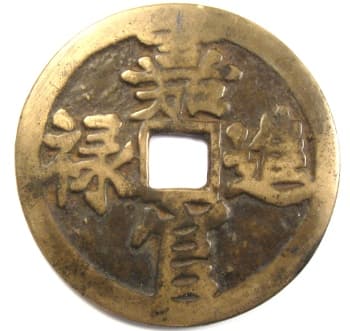
This is a very large charm expressing the wish to obtain promotion to an official office.
The obverse side has the four Chinese characters jia guan jin lu (嘉官进禄). The meaning is "may office and salary be bestowed upon you".
This was a common and auspicious inscription of the Ming (1368 - 1644 AD) and Qing (Ch'ing) (1644 - 1911 AD) dynasties.
Reportedly, the saying originally came from a historical text of the Jin Dynasty (1115 - 1234 AD) where it was stated "When the phoenix flies outside, envoys will arrive, when inside, office and salary will be bestowed".
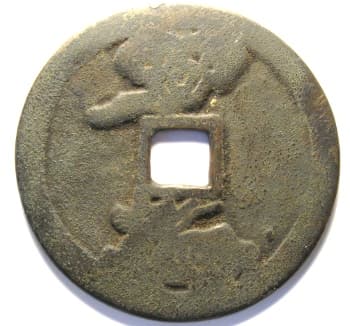 The
reverse side of this charm, unfortunately, is very black.
The
reverse side of this charm, unfortunately, is very black.Above the square hole is an "auspicious cloud" with a crescent moon at its very top. Below the hole is a deer.
The Chinese like to use verbal and visual puns. The character for cloud (云) and the character for luck and fortune (运) are both pronounced yun.
The cloud is also shaped like a ruyi sceptre which has the meaning of "as you wish".
Also, the character for deer (鹿) is pronounced lu which is exactly the same pronunciation as the character (禄) on the obverse side referring to the salary of a government official.
Even more interesting, the deer is often used to refer to the God of Prosperity. This is because Lu (禄), the God of Prosperity, is also pronounced the same as the character for deer.
Therefore, the pictures say "good luck" (cloud) in obtaining an "official's salary" (deer) "as you wish" (ruyi shape of cloud) which mimics the inscription in Chinese characters on the obverse side.
While most Chinese numismatists feel the animal symbol depicted on this charm is a deer, they are those who offer alternative interpretations. Some have proposed that the animal is actually a rhinoceros. The horn of the rhino has traditionally been highly prized for its medicinal value. It is believed to be able to cure a wide range of illnesses and is considered to be an antidote to poison. A single or pair of rhino horns is also one of the eight treasures. The rhino, however, is not frequently seen depicted in other forms of the Chinese arts so this interpretation regarding this particular charm is still open to discussion.
However, an old Chinese charm depicting the rhinoceros is discussed here.
Another interpretation is that the animal is a water buffalo or ox. This type of charm first appeared during the Song Dynasty. There is a motif in Chinese ceramics known as the "Wu buffalo gasping at the moon" (wu niu chuan yue 吴牛喘月). The ancient kingdom of Wu (222 - 280 AD) existed in the area of the Changjiang (Yangtze) and Huai Rivers. For this reason, the water buffalo of this area have been historically referred to as "Wu buffalo". Under the intense heat of the summer sun, water buffalo were often seen gasping for air. Even during summer nights the buffalo would sometimes mistake the moon for the sun and continue to gasp for air. It is believed that this art motif has a hidden meaning in that it alludes to the suffering of the Chinese of the Northern Song (960 - 1127 AD) during the time they were ruled by the Nuzhen nationality which established the Jin Dynasty (1115 - 1234 AD).
The diameter of this charm is 61 mm.
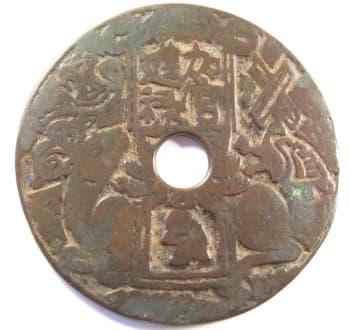 This is another large
charm with the same inscription and theme as the charm above
but incorporating several additional symbols.
This is another large
charm with the same inscription and theme as the charm above
but incorporating several additional symbols.In this case, the four-character inscription is written in two columns above the round hole and below the canopy. The inscription, which is the same as that on the charm above, is read (top, bottom, top, bottom) beginning at the right as jia guan jin lu (加官进禄).
There is one difference in the inscription. The first character on this charm is written as "加" (jia) instead of "嘉" (jia). The character "加" (jia) has the meaning "to appoint" or "to raise to" so the translation of the inscription is still "may office and salary be bestowed upon you".
This charm also has a very large deer lying down below the hole. The head of the deer is just to the left of the hole and is pointing at the inscription. As mentioned above, the character for deer (lu 鹿) has the same pronunciation as the character for the salary of a government official (lu 禄) which is one of the characters in the inscription.
Just above the head of the deer, near the rim at the ten o'clock position, is a silver ingot (sycee 细 丝 or yuanbao 元宝) which symbolizes wealth.
The symbol that resembles an "X" at the two o'clock position is actually a pair of castanets called yin yang ban (阴阳板). It is believed that Chinese castanets were derived from the jade tablets used to authorize access to the imperial palace.
At the three o'clock position near the rim is a rhinoceros horn (xi jiao 犀角) which is a symbol for happiness because the first character (xi 犀) is pronounced the same as the character for happiness (xi 喜).
You will notice that the deer has a saddle which is just below the round hole. On the saddle is drawn a monkey. The character for monkey (hou 猴) has the same pronunciation as the character which means "a marquis (i.e. a high official)" (hou 侯). This rebus involving a "high official" also refers back to the inscription which includes the character for an "official" or "mandarin" (guan 官).
The hidden meaning is the wish to be appointed to a high office (the pun composed of "monkey" and "marquis") and receive a large government salary (the pun consisting of the "deer" and "salary").
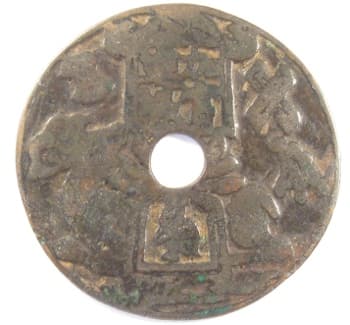
There are actually two versions of this charm known to exist.
At the left is the second variety.
The major difference is that this specimen has less ornamentation between the various symbols.
In this image, the silver ingot above the deer's head can be more easily seen, as can the pair of castanets and the rhinoceros horn on the right side of the charm.
Both these charms show considerable wear and would date from the Song Dynasty (960-1279 AD).
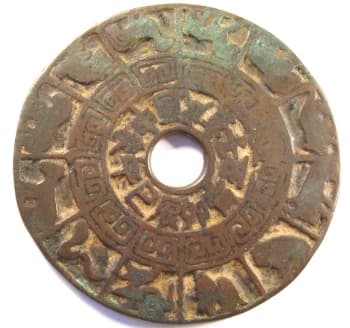 The
reverse side of this charm displays along the rim the twelve
animals of the Chinese zodiac.
The
reverse side of this charm displays along the rim the twelve
animals of the Chinese zodiac.These animals are the Rat, Ox, Tiger, Rabbit, Dragon, Snake, Horse, Sheep, Monkey, Rooster, Dog and Boar (Pig).
The corresponding Earthly Branch linked to each animal is shown next to the round hole.
The Earthly Branches (地支) consist of 子 (zi), 丑 (chou), 寅 (yin), 卯 (mao), 辰 (chen), 巳 (si), 午 (wu), 未 (wei), 申 (shen), 酉 (you), 戌 (xu) and 亥 (hai).
For a more detailed discussion of the Chinese zodiac and the Twelve Earthly Branches please visit Ancient Chinese Zodiac Charms.
This charm has a diameter of 55 mm and a weight of 33 grams.
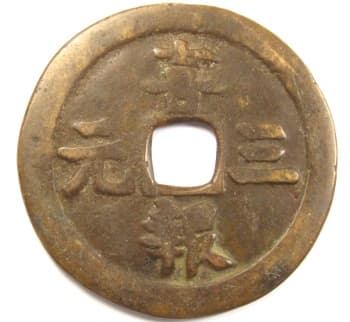 This is another old
charm expressing the desire for success in the examination
system and promotion to an official position that has fun
playing with the hidden meanings and sounds of Chinese
characters, animals and plants.
This is another old
charm expressing the desire for success in the examination
system and promotion to an official position that has fun
playing with the hidden meanings and sounds of Chinese
characters, animals and plants.The inscription on the obverse side is read top to bottom and right to left. It reads xi bao san yuan (喜报三元). Xi (喜) means "happiness". Bao (报) means "to report". San (三) means "three" and yuan (元) refers to the imperial examinations. A rough translation would be "good news of a triple first in the imperial examinations".
For reference purposes, the top rankings in the three examinations were:
- jie yuan (解元)
which means first on the list for the second degree.
This would be the top scholar in the rural areas.
- hui yuan (会元)
which means first on the list of the examination for jin shi (进士).
This would be the top scholar in the second round or capital
examinations.
- zhuang yuan (状元)
which means the highest graduate of the Hanlin
Academy. This would be the top scholar in the third
and final round of imperial examinations.
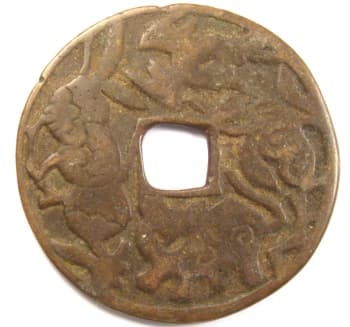 This is the
reverse side of the charm. At the very top, and "upside
down" in this view, is a magpie
which is a bird that belongs to the same family as crows,
ravens and jays. The Chinese for magpie is xi que (喜鹊). You
will note that the first character is the same xi (喜) meaning
"happiness" which is the character at the top of the
obverse side. To the Chinese, a chattering magpie
signifies "good news" and an "upside down" magpie would mean
that the "good news" has "arrived" (please see Hidden Meaning of Symbols for
further explanation).
This is the
reverse side of the charm. At the very top, and "upside
down" in this view, is a magpie
which is a bird that belongs to the same family as crows,
ravens and jays. The Chinese for magpie is xi que (喜鹊). You
will note that the first character is the same xi (喜) meaning
"happiness" which is the character at the top of the
obverse side. To the Chinese, a chattering magpie
signifies "good news" and an "upside down" magpie would mean
that the "good news" has "arrived" (please see Hidden Meaning of Symbols for
further explanation).At the very bottom is a leopard. The Chinese for leopard is bao (豹) which has the same pronunciation as "to report" (报) which is the character at the bottom of the obverse side.
To the right are three branches or twigs which is the same position as the san (三), meaning three, on the obverse side.
Finally, to the left are three round-shaped fruits. The Chinese for "round" is yuan (园) which is the same pronunciation as yuan (元), referring to the names of the examinations, on the left of the obverse side. Also, the character 园 for "round" has the same character 元 for "examinations" in its middle.
Additionally, the Chinese for "fruit" (果) has the meaning of "results" such as in an examination.
Finally, the three round-shaped fruits appear to be pomegranates. To the Chinese, the large number of seeds of the pomegranate symbolize many male children earning fame, fortune and rank.
Therefore, the pictures depicted on the reverse side (magpie, leopard, three, "round" fruits) can be read as xi bao san yuan which is the same reading as the inscription on the obverse side.
The charm has a diameter of 53 mm and a weight of 29.6 grams.
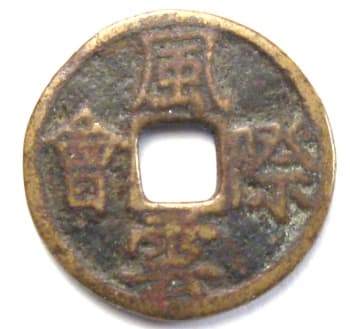
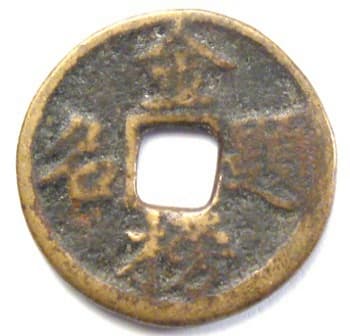 The charm
shown here very closely resembles a small Chinese temple
coin.
The charm
shown here very closely resembles a small Chinese temple
coin.The inscription on the obverse side (far left) is feng yun ji hui (风云际会) which literally means a "meeting of wind and clouds" but here is referring to a "gathering of the talented and able".
The inscription on the reverse side (near left) is jin bang ti ming (金榜题名) which means a "golden list of those who have obtained a degree".
The entire inscription can thus be understood to mean a "gathering of the talented and able who have been successful in the imperial examination".
This small charm has a diameter of 15.5 mm and a weight of 1.1 grams.
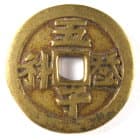 This charm
expresses the desire for a large family with many sons and the
wish that they will all be successful in achieving the rank of
a high government position.
This charm
expresses the desire for a large family with many sons and the
wish that they will all be successful in achieving the rank of
a high government position.The inscription wu zi deng ke (五子登科) means "may your five sons achieve great success in the imperial examinations".
The greatest achievement a Chinese family could hope for was to have a son (or five sons!) be successful in the examinations and achieve a high government office which would then bring wealth and honor to the family.
It was believed that the ideal family size was five sons and two daughters. Chinese parents have traditionally favored sons for several reasons. Sons are responsible for continuing the ancestral lineage and carrying out ancestor worship. Also, when sons grow up they are responsible for taking care of their parents. When daughters grown up, they marry, leave home and then are responsible for taking care of their in-laws.
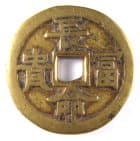 This is the other side of
this charm which expresses the sentiment for a long life,
wealth and a good government position.
This is the other side of
this charm which expresses the sentiment for a long life,
wealth and a good government position.The inscription reads chang ming fu gui (长命富贵) which means "longevity, wealth and honor".
It is also interesting that the character meaning "wealth" (fu 富) at the right of the square hole is missing the very top vertical stroke. It is possible that this was done intentionally. Since the fu character has no "head" or "top", the amount of wealth would be without limit.
The charm has a diameter of 29.8 mm and weighs 12.3 grams.
Good Luck, Wealth and Happiness "According to your Wishes"
One of the largest general
categories of Chinese charms include those seeking "good
luck", wealth and happiness "according to your wishes"
such as the charms discussed below.
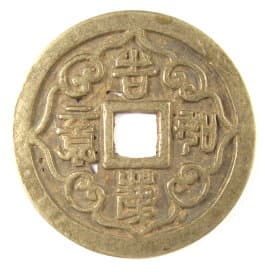
This is a very interesting four character charm with the subject of good luck and happiness.
The obverse side has four characters written in ancient seal script.
The legend is read top to bottom and right to left as ji qing ru yi (吉庆如意). The first character is ji (吉) which means "lucky", "happy" or "auspicious". The second character is qing (庆) which means "good luck" or "congratulate". The last two characters are ruyi (如意) which means "according to your wishes". The entire inscription can be roughly translated in English to mean "may your happiness be according to your wishes".
The charm is 60 mm in diameter.
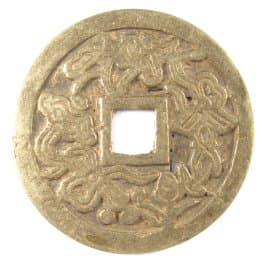
The reverse side has no inscription and, at first glance, seems to have a random nondescript design pattern. It is, however, rich in symbolism.
At the very top is a Chinese halberd (ji 戟) which is an ancient infantry weapon consisting of a shaft (seen running horizontally from about the 1 o'clock position) with a spear and crescent shaped blade on the other end. (The halberd is outlined in black in the image below.) The Chinese word for "halberd" and the Chinese word for "lucky" or "auspicious" in the inscription on the obverse side are both pronounced ji. The Chinese word (级) for steps or ranks (as in grades of officers) is also pronounced ji.
To the right of the square hole is a stone chime (qing 磬) which was an ancient musical instrument. It was usually made of jade and looked a little like a triangular plate. If you look at the charm you will see what appears to be a pair of wings at about the 3 o'clock position. This is the stone chime. It has a hole at its very top where it would be suspended by a string so that it would vibrate with sound when struck. (The stone chime is outlined in red in the image below.) In Chinese, the pronunciation of the character for "stone chime" (磬) and the pronunciation of the character for "congratulate" (庆) in the inscription on the obverse side are both pronounced qing.
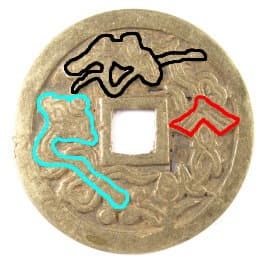 If you look carefully at
about the 9 o'clock position you will see the head of an
S-shaped object which extends downward to about the middle
bottom of the charm. This object is called a ruyi (如意). (The
ruyi is outlined in blue
in the image to the left.) The ruyi was an ancient
sceptre, usually made of jade, which represented
power and authority. Originally, it was actually a short
sword with a sword-guard used for self-defense and
gesturing. It now symbolizes good wishes and prosperity.
Both
the
pronunciation
and
Chinese
characters
for
the
"ruyi" sceptre are exactly the same as those of
the ruyi (如
意) in the inscription on the obverse side meaning "according
to your wishes".
If you look carefully at
about the 9 o'clock position you will see the head of an
S-shaped object which extends downward to about the middle
bottom of the charm. This object is called a ruyi (如意). (The
ruyi is outlined in blue
in the image to the left.) The ruyi was an ancient
sceptre, usually made of jade, which represented
power and authority. Originally, it was actually a short
sword with a sword-guard used for self-defense and
gesturing. It now symbolizes good wishes and prosperity.
Both
the
pronunciation
and
Chinese
characters
for
the
"ruyi" sceptre are exactly the same as those of
the ruyi (如
意) in the inscription on the obverse side meaning "according
to your wishes".Therefore, the pictures on the reverse side (ji=halberd, qing=stone chime, ruyi=ruyi sceptre) say the same thing in symbols as the Chinese characters on the obverse side (ji=吉, qing=庆, ruyi=如意), namely "may your happiness be according to your wishes".
Since the pronunciation of halberd (ji 戟) is the same for both "happiness" (ji 吉) and "rank" (ji 级), the symbols could also be taken to mean "may your rank be according to your wishes".
The pictures are a little difficult to discern because they are all wrapped or tied with "fillets" which are ribbons. The Chinese like to tie ribbons around charms and other objects to represent rays or aura. The ribbons are usually red because red (hong 红) is emblematic of good luck. For more on the symbolic meaning of ribbons please see the entry "ribbons and fillets" at Hidden Meaning of Chinese Charm Symbols.
For another example of a charm with the halberd, stone chime and sceptre symbols please see the large "eight character" charm in the section below.
Both the ruyi sceptre and the stone chime are included in the "eight treasures". For more information on the eight treasures please see Chinese Charms -- The Eight Treasures.
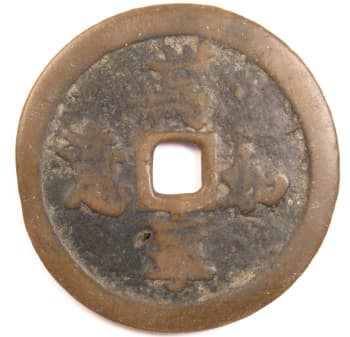
The old charm at the left shows considerable wear reflecting many, many years of use.
The inscription is actually a very popular Chinese saying.
The inscription, written top to bottom and right to left, is wan shi ru yi (万事如意) which means "may things go as you wish" or "may everything go smoothly".
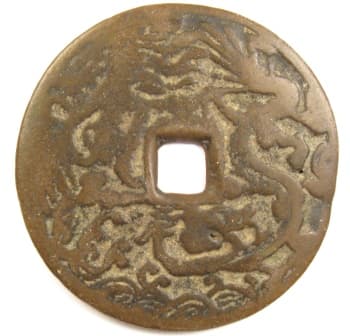
The reverse side of the charm depicts a dragon on the right and a phoenix on the left.
The combination of a dragon and phoenix is a symbol for another auspicious saying, namely long feng cheng xiang (龙凤呈样) which means "prosperity brought by the dragon and phoenix" or, more generally, may you have excellent good fortune.
At the very bottom of the charm can be seen an ocean with waves.
The charm has a diameter of 52 mm and a weight of 28.4 grams.
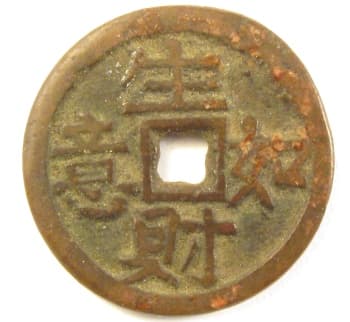
This is another "according to your wishes" charm.
The inscription reads sheng cai ru yi (生财如意) which translates as "become wealthy according to your wishes".
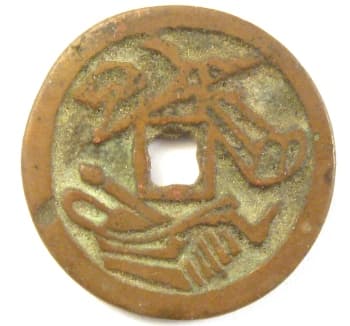 The reverse
side of the charm displays a number of symbols.
The reverse
side of the charm displays a number of symbols.At the 12 o'clock position is the curved blade of a Chinese halberd (ji 戟) which was described above. The shaft of the halberd extends downwards to about the 3 o'clock position.
The Chinese word for "halberd" (戟) and the Chinese word for "lucky" (吉) are both pronounced ji.
At the 11 o'clock position is the head of a ruyi sceptre (如 意) similar to the one discussed above. The shaft of the sceptre angles up and extends across the top of the charm to the one o'clock position.
The Chinese word for ruyi sceptre (如意) and the Chinese expression for "according to your wishes" (如 意) are the same.
These two symbols can thus be interpreted to mean "good luck according to your wishes".
Unfortunately, I am not able to identify the other symbols on this charm with certainty.
I think the shaft of the halberd extends down into a vase. The Chinese word for vase (ping 瓶) has the same pronunciation as the word for peace (pingan 平安) and thus symbolizes the wish for peace.
I have not seen the symbol or symbols located below the square hole on any other charm. If you can identify these symbols, I would be most grateful if you would contact me.
The charm has a diameter of 21.3 mm and a weight of 3.6 grams.
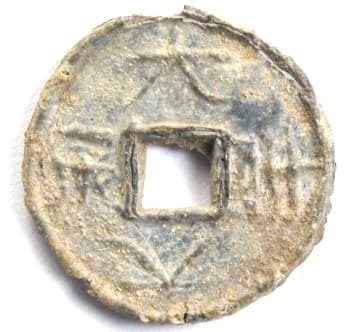
This charm has a very auspicious inscription which is read clockwise, beginning at the top, as da ji da li (大吉大利). Each character is oriented with its bottom next to the square hole which explains why, for example, the da (大) character below the square hole is upside-down.
The Chinese word ji li (吉 利) means "lucky" or "auspicious". The Chinese character da (大) means "great", and appears twice, so the inscription translates as "very good luck" or "great luck".
This charm is made of lead and was made in Dali in Yunnan Province during the Ming Dynasty (1368-1644).
The diameter is 23 mm and the weight is 4 grams.
Longevity, Wealth and Honor
The Chinese have always
esteemed and honored those who have reached old age.
It is no surprise, then, that a large number of charms
express the desire to live a long life with honor and
prosperity.
Several examples of longevity, wealth and honor charms are displayed and explained in this section.
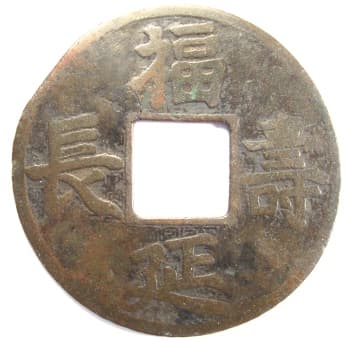 This is a very
old and very worn charm.
This is a very
old and very worn charm.
The inscription can be read in two ways although the meaning for both is the same. Some people read the inscription (top, bottom, right, left) as fu yan shou chang (福延寿长). The alternative reading (clockwise starting at the top) is fu shou yan chang (福寿延长).
The inscription translates as "good fortune and longevity for a long time".
Another charm with this same inscription written in both Chinese characters and Daoist "magic writing" is discussed in detail at Daoist (Taoist) Charms.
An outstanding characteristic of this charm is that the entire surface is covered with the pattern of small squares, referred to as a "meander", that is frequently seen on ancient Chinese bronzes and mirrors.
Unfortunately, the wear on the charm makes it difficult to see this pattern.
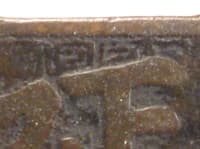
At the left is a close-up of the area between the bottom character (yan 延) and the square hole.
The pattern of repeating rectangular spirals, that actually covers the entire surface of the obverse side of the charm, can be easily seen here.
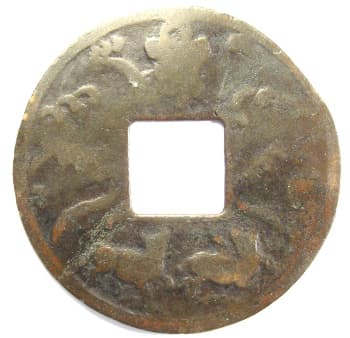 The symbols on
the reverse side of the charm are also difficult to see
clearly.
The symbols on
the reverse side of the charm are also difficult to see
clearly.
At the very top, at the 12 o'clock position, is a circle that represents the moon (yue 月).
Just below the moon is an "auspicious cloud" (xiangyun 祥云). The Chinese word for "cloud" (yun 云) has the same pronunciation as the Chinese word for "luck" or "fortune" (yun 运).
On the right and left sides of the square hole are waves.
At the very bottom of the charm are two rhinoceroses.
The rhinoceros horn is considered to be very valuable and is one of the Eight Treasures.
The rhinoceros (xi niu 犀牛) is also a symbol for "happiness" because its pronunciation is similar to the word for "happiness" (xi 喜). Two rhinoceros therefore represent the familiar and joyous Chinese expression of "double happiness" (shuang xi 双喜).
The rhinoceros existed in southern China during very ancient times but then became extinct. The rhino subsequently took on a more legendary and mythic existence in the minds of the Chinese.
It was believed that the stars in the sky were reflected in the veins and patterns of a rhinoceros horn. The ancient Chinese further believed that because of this close association with the heavens, the horn of the rhinoceros could emit a vapor that could penetrate water, traverse the sky and communicate directly with the spirits.
These special patterns on the rhino horn were believed to appear when the animal "gazed at the moon".
The Chinese have an expression "the rhinoceros gazing at the moon" (xi niu wang yue 犀牛望 月) which helps to explain the meaning of the symbols on this charm. If you observe closely, you will notice that the two rhinoceros have their heads turned and are "gazing" at the moon. Their horns have the magical power to penetrate the waves on each side of the charm and communicate directly with the moon located above the "auspicious" clouds.
This magical communication of the rhinoceros with the moon, stars and spirits has, over the centuries, taken on an extended meaning. The expression "the rhinoceros gazing at the moon" is now used in more romantic settings. This mystical connection has become a metaphor indicating a direct connection between the hearts of lovers who, by gazing at the moon, can be close to one another though they may be physically separated by great distances.
Another Chinese expression with a similar sentiment is hua qian yue xia (花前月下) which means "in front of the flowers and under the moon". A charm illustrating this theme is discussed at Chinese Marriage Charms.
This large charm has a diameter of 63 mm and a weight of 30 grams.
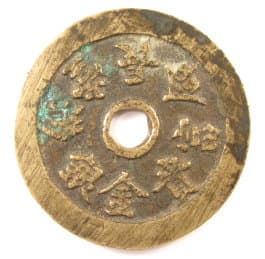
This is an example of a large eight character charm with the entire inscription on one side. (For another example, please see The Eight Treasures).
The charm has a round central hole instead of a square one.
The inscription, starting at the very top and reading clockwise is chang ming fu gui jin yin man tang (长 命富贵金 银满 堂). The first four characters wish for "longevity, wealth and honor". The last four characters are almost identical to that on the obverse side of the above charm. Instead of saying "may gold and jade fill your house (halls)", however, it says "may gold and silver fill your house (halls)".
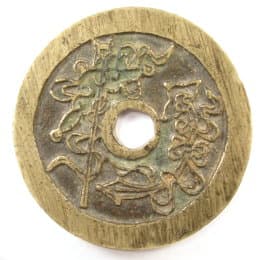 This complicated
design pattern is very similar to that on the reverse side
of the large
seal script charm in the "Four Character Charms"
section above. You may want to refer to that other
charm to help differentiate the various symbols.
This complicated
design pattern is very similar to that on the reverse side
of the large
seal script charm in the "Four Character Charms"
section above. You may want to refer to that other
charm to help differentiate the various symbols.
To the left of the round hole is the Chinese halberd (ji 戟). The shaft of the weapon runs vertically with the hatchet-shaped blade at the top near the rim at about the 11 o'clock position. (The halberd is outlined in black in the image below.)
Superimposed over the halberd is the stone chime (qing 磬). The three end points of this triangular-shaped musical instrument are marked with little circles. The right end point is at about 12 o'clock, the middle end point (where the string to suspend the instrument would be tied) is at about the 10 or 11 o'clock position, and the left end point is at about the 9 o'clock position. If you connect these three points, you will see the triangular shaped stone chime musical instrument. (The stone chime is outlined in red in the image below.)
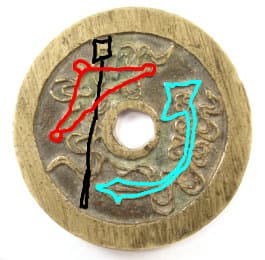 To the right of the circular hole is the sceptre (ruyi 如
意). The head portion is the roughly triangular
shaped object at about the 2 o'clock position. The
shaft of the sceptre curves down to where it ends at the 6
o'clock position. (The ruyi is outlined in blue
in the image to the left.)
To the right of the circular hole is the sceptre (ruyi 如
意). The head portion is the roughly triangular
shaped object at about the 2 o'clock position. The
shaft of the sceptre curves down to where it ends at the 6
o'clock position. (The ruyi is outlined in blue
in the image to the left.)
As is the case with the similar four-character charm above, the halberd, stone chime and sceptre are all wrapped or tied with a fillet (ribbon), which in reality would be red, denoting "good luck".
The reverse side therefore says in pictures the following: halberd, stone chime, sceptre = ji (happy or rank) qing (good luck, congratulate) ruyi (as you wish). The meaning may be translated as "may your happiness (or your rank) be according to your wishes".
The charm is 60 mm in diameter.
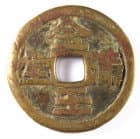 The charm on
the left has one of the most common inscriptions
regarding wealth and prosperity. The inscription
on the obverse is jin
yu man tang (金玉满堂). The meaning is "may
gold and jade fill your house (hall)".
The charm on
the left has one of the most common inscriptions
regarding wealth and prosperity. The inscription
on the obverse is jin
yu man tang (金玉满堂). The meaning is "may
gold and jade fill your house (hall)".
I find this inscription to be most interesting and revealing. The original verse jin yu man tang (金玉满堂) is from the Dao De Jing (Tao Te Ching 道德经), the classic Taoist (Daoist) text historically attributed to Laozi (老子). The original verse can be translated as "when gold and jade fill the hall, their possessor cannot keep them safe". The implication is that having wealth makes a person feel unsafe because he will then worry that his money and belongings may be stolen. But, if a person does not strive for "gold and jade" and, therefore, lacks wealth and possessions, he will be at peace with the Dao (道). He will not have any such worries. Therefore, the original meaning of the verse has become corrupted over time because it is now used on charms as a fervent desire to have "gold and jade".
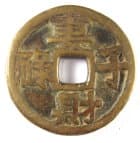
The hope for wealth and prosperity, a large family with many sons, and successful promotion to a government office is expressed on the reverse side. The four character inscription is qi cai zi lu (妻财子禄) which would translate as "wife, wealth, sons and emolument (which was the salary a government official received)".
This charm has a diameter of 28.1 mm and weighs 10 grams.
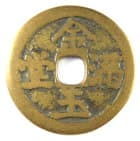
The obverse side of this charm also has the legend jin yu man tang (金玉满堂), meaning "may gold and jade fill your house."
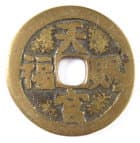 The reverse
side of this good fortune charm reads tian guan ci fu
(天官赐福) which translates as "may the Ruler of Heaven
bestow good fortune". Tian Guan (天
官) was one of
the three deities of the Taoist (Daoist) pantheon
known as the san
guan (三官). He kept a register of the
good and evil deeds of the people and bestowed wealth
and good luck.
The reverse
side of this good fortune charm reads tian guan ci fu
(天官赐福) which translates as "may the Ruler of Heaven
bestow good fortune". Tian Guan (天
官) was one of
the three deities of the Taoist (Daoist) pantheon
known as the san
guan (三官). He kept a register of the
good and evil deeds of the people and bestowed wealth
and good luck.
The diameter is 27.8 mm and the weight is 5.4 grams.
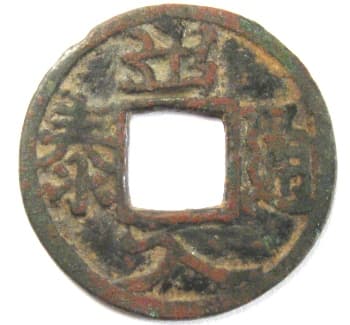
The charm at the left has the inscription chu ru tong tai (出入通泰).
Chu (出) means "to go out" and ru (入) means "to enter".
Tong (通) means "to succeed" and tai (泰) means "prosperous".
The inscription expresses the meaning that a person leaves and then returns having become successful and prosperous.
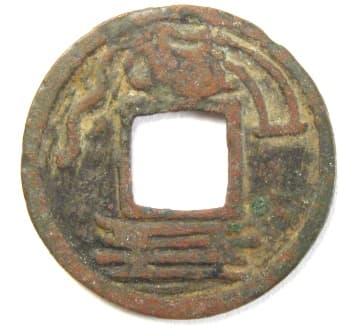 The meaning of the
inscription is more graphically depicted on the reverse
side of the charm.
The meaning of the
inscription is more graphically depicted on the reverse
side of the charm.
Above the square hole is a horse saddle (ma an 马鞍) with the reins hanging down to the left of the hole.
An ancient Chinese sedan chair (jiao zi 轿子), which would be carried by bearers, is shown below the square hole.
The implied meaning is that a person would leave home on a horse. He would be successful in the imperial examinations and attain a lucrative government post, or he would become a wealthy businessman. As a result of his success, he would return home on a sedan chair.
This charm has a diameter of 25.5 mm and a weight of 3 grams.
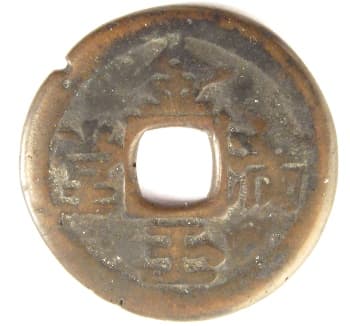
This is the obverse side of another old Chinese charm with the popular inscription jin yu man tang (金玉满堂) meaning "may gold and jade fill your house."
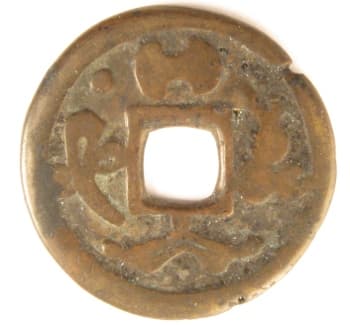 Unlike the
charms described above, however, the reverse side does
not have an auspicious saying but instead displays
four symbols of wealth and prosperity.
Unlike the
charms described above, however, the reverse side does
not have an auspicious saying but instead displays
four symbols of wealth and prosperity.
Above the square hole is a silver ingot (sycee 细 丝 or yuanbao 元宝) which symbolizes wealth.
To the right of the hole is a precious pearl (bao zhu 宝珠). The pearl is a symbol of riches and is frequently shown with flames which enhances its magical powers.
At the left of the square hole is a rhinoceros horn (xijiao 犀角) tied with a ribbon or fillet. The rhino horn symbolizes happiness because the first character (xi 犀) has the same pronunciation as the character for happiness (xi 喜).
Below the hole is a chime stone (qing 磬) which was a percussion musical instrument in ancient China. A small hole at the top center allowed it to be hung from a frame and when struck with a mallet it would produce a sound. The musical instrument consisted of a set of 8 to 24 of these chime stones tuned to different pitches. Many of these chime stones were made of jade.
This charm has a diameter of 29 mm and a weight of 7.3 grams.
Several examples of longevity, wealth and honor charms are displayed and explained in this section.
 This is a very
old and very worn charm.
This is a very
old and very worn charm.The inscription can be read in two ways although the meaning for both is the same. Some people read the inscription (top, bottom, right, left) as fu yan shou chang (福延寿长). The alternative reading (clockwise starting at the top) is fu shou yan chang (福寿延长).
The inscription translates as "good fortune and longevity for a long time".
Another charm with this same inscription written in both Chinese characters and Daoist "magic writing" is discussed in detail at Daoist (Taoist) Charms.
An outstanding characteristic of this charm is that the entire surface is covered with the pattern of small squares, referred to as a "meander", that is frequently seen on ancient Chinese bronzes and mirrors.
Unfortunately, the wear on the charm makes it difficult to see this pattern.

At the left is a close-up of the area between the bottom character (yan 延) and the square hole.
The pattern of repeating rectangular spirals, that actually covers the entire surface of the obverse side of the charm, can be easily seen here.
 The symbols on
the reverse side of the charm are also difficult to see
clearly.
The symbols on
the reverse side of the charm are also difficult to see
clearly.At the very top, at the 12 o'clock position, is a circle that represents the moon (yue 月).
Just below the moon is an "auspicious cloud" (xiangyun 祥云). The Chinese word for "cloud" (yun 云) has the same pronunciation as the Chinese word for "luck" or "fortune" (yun 运).
On the right and left sides of the square hole are waves.
At the very bottom of the charm are two rhinoceroses.
The rhinoceros horn is considered to be very valuable and is one of the Eight Treasures.
The rhinoceros (xi niu 犀牛) is also a symbol for "happiness" because its pronunciation is similar to the word for "happiness" (xi 喜). Two rhinoceros therefore represent the familiar and joyous Chinese expression of "double happiness" (shuang xi 双喜).
The rhinoceros existed in southern China during very ancient times but then became extinct. The rhino subsequently took on a more legendary and mythic existence in the minds of the Chinese.
It was believed that the stars in the sky were reflected in the veins and patterns of a rhinoceros horn. The ancient Chinese further believed that because of this close association with the heavens, the horn of the rhinoceros could emit a vapor that could penetrate water, traverse the sky and communicate directly with the spirits.
These special patterns on the rhino horn were believed to appear when the animal "gazed at the moon".
The Chinese have an expression "the rhinoceros gazing at the moon" (xi niu wang yue 犀牛望 月) which helps to explain the meaning of the symbols on this charm. If you observe closely, you will notice that the two rhinoceros have their heads turned and are "gazing" at the moon. Their horns have the magical power to penetrate the waves on each side of the charm and communicate directly with the moon located above the "auspicious" clouds.
This magical communication of the rhinoceros with the moon, stars and spirits has, over the centuries, taken on an extended meaning. The expression "the rhinoceros gazing at the moon" is now used in more romantic settings. This mystical connection has become a metaphor indicating a direct connection between the hearts of lovers who, by gazing at the moon, can be close to one another though they may be physically separated by great distances.
Another Chinese expression with a similar sentiment is hua qian yue xia (花前月下) which means "in front of the flowers and under the moon". A charm illustrating this theme is discussed at Chinese Marriage Charms.
This large charm has a diameter of 63 mm and a weight of 30 grams.

This is an example of a large eight character charm with the entire inscription on one side. (For another example, please see The Eight Treasures).
The charm has a round central hole instead of a square one.
The inscription, starting at the very top and reading clockwise is chang ming fu gui jin yin man tang (长 命富贵金 银满 堂). The first four characters wish for "longevity, wealth and honor". The last four characters are almost identical to that on the obverse side of the above charm. Instead of saying "may gold and jade fill your house (halls)", however, it says "may gold and silver fill your house (halls)".
 This complicated
design pattern is very similar to that on the reverse side
of the large
seal script charm in the "Four Character Charms"
section above. You may want to refer to that other
charm to help differentiate the various symbols.
This complicated
design pattern is very similar to that on the reverse side
of the large
seal script charm in the "Four Character Charms"
section above. You may want to refer to that other
charm to help differentiate the various symbols.To the left of the round hole is the Chinese halberd (ji 戟). The shaft of the weapon runs vertically with the hatchet-shaped blade at the top near the rim at about the 11 o'clock position. (The halberd is outlined in black in the image below.)
Superimposed over the halberd is the stone chime (qing 磬). The three end points of this triangular-shaped musical instrument are marked with little circles. The right end point is at about 12 o'clock, the middle end point (where the string to suspend the instrument would be tied) is at about the 10 or 11 o'clock position, and the left end point is at about the 9 o'clock position. If you connect these three points, you will see the triangular shaped stone chime musical instrument. (The stone chime is outlined in red in the image below.)
 To the right of the circular hole is the sceptre (ruyi 如
意). The head portion is the roughly triangular
shaped object at about the 2 o'clock position. The
shaft of the sceptre curves down to where it ends at the 6
o'clock position. (The ruyi is outlined in blue
in the image to the left.)
To the right of the circular hole is the sceptre (ruyi 如
意). The head portion is the roughly triangular
shaped object at about the 2 o'clock position. The
shaft of the sceptre curves down to where it ends at the 6
o'clock position. (The ruyi is outlined in blue
in the image to the left.)As is the case with the similar four-character charm above, the halberd, stone chime and sceptre are all wrapped or tied with a fillet (ribbon), which in reality would be red, denoting "good luck".
The reverse side therefore says in pictures the following: halberd, stone chime, sceptre = ji (happy or rank) qing (good luck, congratulate) ruyi (as you wish). The meaning may be translated as "may your happiness (or your rank) be according to your wishes".
The charm is 60 mm in diameter.
 The charm on
the left has one of the most common inscriptions
regarding wealth and prosperity. The inscription
on the obverse is jin
yu man tang (金玉满堂). The meaning is "may
gold and jade fill your house (hall)".
The charm on
the left has one of the most common inscriptions
regarding wealth and prosperity. The inscription
on the obverse is jin
yu man tang (金玉满堂). The meaning is "may
gold and jade fill your house (hall)".I find this inscription to be most interesting and revealing. The original verse jin yu man tang (金玉满堂) is from the Dao De Jing (Tao Te Ching 道德经), the classic Taoist (Daoist) text historically attributed to Laozi (老子). The original verse can be translated as "when gold and jade fill the hall, their possessor cannot keep them safe". The implication is that having wealth makes a person feel unsafe because he will then worry that his money and belongings may be stolen. But, if a person does not strive for "gold and jade" and, therefore, lacks wealth and possessions, he will be at peace with the Dao (道). He will not have any such worries. Therefore, the original meaning of the verse has become corrupted over time because it is now used on charms as a fervent desire to have "gold and jade".

The hope for wealth and prosperity, a large family with many sons, and successful promotion to a government office is expressed on the reverse side. The four character inscription is qi cai zi lu (妻财子禄) which would translate as "wife, wealth, sons and emolument (which was the salary a government official received)".
This charm has a diameter of 28.1 mm and weighs 10 grams.

The obverse side of this charm also has the legend jin yu man tang (金玉满堂), meaning "may gold and jade fill your house."
 The reverse
side of this good fortune charm reads tian guan ci fu
(天官赐福) which translates as "may the Ruler of Heaven
bestow good fortune". Tian Guan (天
官) was one of
the three deities of the Taoist (Daoist) pantheon
known as the san
guan (三官). He kept a register of the
good and evil deeds of the people and bestowed wealth
and good luck.
The reverse
side of this good fortune charm reads tian guan ci fu
(天官赐福) which translates as "may the Ruler of Heaven
bestow good fortune". Tian Guan (天
官) was one of
the three deities of the Taoist (Daoist) pantheon
known as the san
guan (三官). He kept a register of the
good and evil deeds of the people and bestowed wealth
and good luck.The diameter is 27.8 mm and the weight is 5.4 grams.

The charm at the left has the inscription chu ru tong tai (出入通泰).
Chu (出) means "to go out" and ru (入) means "to enter".
Tong (通) means "to succeed" and tai (泰) means "prosperous".
The inscription expresses the meaning that a person leaves and then returns having become successful and prosperous.
 The meaning of the
inscription is more graphically depicted on the reverse
side of the charm.
The meaning of the
inscription is more graphically depicted on the reverse
side of the charm.Above the square hole is a horse saddle (ma an 马鞍) with the reins hanging down to the left of the hole.
An ancient Chinese sedan chair (jiao zi 轿子), which would be carried by bearers, is shown below the square hole.
The implied meaning is that a person would leave home on a horse. He would be successful in the imperial examinations and attain a lucrative government post, or he would become a wealthy businessman. As a result of his success, he would return home on a sedan chair.
This charm has a diameter of 25.5 mm and a weight of 3 grams.

This is the obverse side of another old Chinese charm with the popular inscription jin yu man tang (金玉满堂) meaning "may gold and jade fill your house."
 Unlike the
charms described above, however, the reverse side does
not have an auspicious saying but instead displays
four symbols of wealth and prosperity.
Unlike the
charms described above, however, the reverse side does
not have an auspicious saying but instead displays
four symbols of wealth and prosperity.Above the square hole is a silver ingot (sycee 细 丝 or yuanbao 元宝) which symbolizes wealth.
To the right of the hole is a precious pearl (bao zhu 宝珠). The pearl is a symbol of riches and is frequently shown with flames which enhances its magical powers.
At the left of the square hole is a rhinoceros horn (xijiao 犀角) tied with a ribbon or fillet. The rhino horn symbolizes happiness because the first character (xi 犀) has the same pronunciation as the character for happiness (xi 喜).
Below the hole is a chime stone (qing 磬) which was a percussion musical instrument in ancient China. A small hole at the top center allowed it to be hung from a frame and when struck with a mallet it would produce a sound. The musical instrument consisted of a set of 8 to 24 of these chime stones tuned to different pitches. Many of these chime stones were made of jade.
This charm has a diameter of 29 mm and a weight of 7.3 grams.
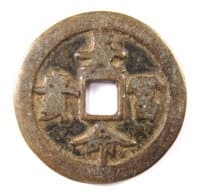
This old charm is very well made but shows a lot of wear. The inscription on the obverse is the same as that of the charm above and reads chang ming fu gui (长 命富贵) meaning "longevity, wealth and honor".
Also, just as the above charm, the fu (富) character for "wealth" located to the right of the square hole is missing its top vertical stroke. This is a subtle way to imply that wealth should be unlimited.
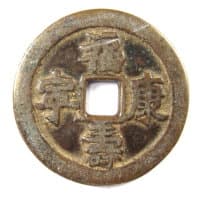 The reverse
side has the inscription fu shou kang ning (福寿康宁) which
translates as "wealth, longevity, health and composure".
The reverse
side has the inscription fu shou kang ning (福寿康宁) which
translates as "wealth, longevity, health and composure".This inscription is a reference to the "Five Blessings" (wufu 五福) first mentioned in the ancient Chinese classic known as the "Book of History". The "Five Blessings" include wealth (fu 富), longevity (shou 寿), health and composure (kangning 康宁), virtue (xiu hao de 修好德), and the desire to die a natural death in old age (lao zhong ming 考 终命).
The charm has a diameter of 38.5 mm and weighs 15.6 grams.
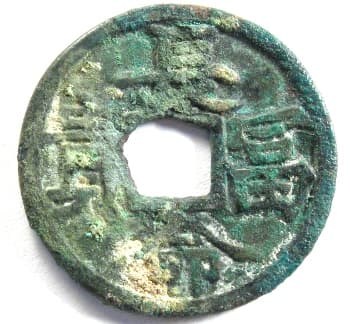
This is another ancient Chinese charm with the popular inscription chang ming fu gui (长命富贵) meaning "longevity, wealth and honor".
Similar to the other charms displayed above, the fu (富) character for "wealth" is missing the short vertical stroke at the top which suggests that wealth should be without limits.
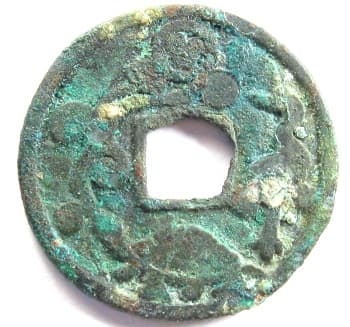
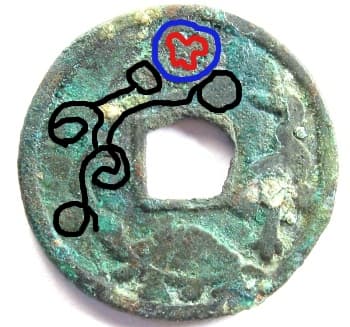 The reverse side of the charm consists
of several symbols which combine to form a couple of
visual puns.
The reverse side of the charm consists
of several symbols which combine to form a couple of
visual puns.To the right of the square hole is a crane (he 鹤) with its head looking up and to the left.
Below the hole is a tortoise (gui 龟).
Because the patina makes it difficult to see the other symbols clearly, I have outlined them in the image to the immediate left.
The long black lines with circles represent a branch of peony (mudan 牡 丹) flowers. At the very end of the branch and inside the blue circle is a rooster or cock (gongji 公鸡) which I have outlined in red.
In popular Chinese culture, the crane and the tortoise both symbolize longevity.
In Chinese, the peony is also known as fuguihua (富贵花) which means "flower of wealth and honor".
The Chinese word for "to crow", as in the crowing of a rooster, is ming (鸣) which has the same pronunciation as the word for "life" (ming 命) in the expression "long life" or "longevity (chang ming 长 命).
The visual pun or rebus is thus constructed as follows. At the end of a long (chang 长) branch is a crowing (ming 命) rooster. The branch is full of peony or fugui hua (富贵花) flowers. The combination chang ming fu gui is thus the same as the inscription chang ming fu gui (长 命富贵) on the obverse side.
Other hidden or implied meanings are at play here as well. The second character in the word for "rooster" (gongji 公鸡) has the same pronunciation as the word for "lucky" or "auspicious" (ji 吉). Also, a "crowing rooster" (gong ming 公 鸣) has the same pronunciation as "merit and fame" (gong ming 功名).
Additionally, the Chinese have the expression "like a crane standing among chickens" (he li ji qun 鹤立鸡群) which means "to stand head and shoulders above others".
There is one additional visual pun. The "tortoise" (gui 龟) and the "crane" (he 鹤) together symbolize the popular saying gui he qi shou (龟 鹤齐寿) which translates as "live as long as the tortoise and the crane".
This charm has a diameter of 26 mm and a weight of 3.4 grams.
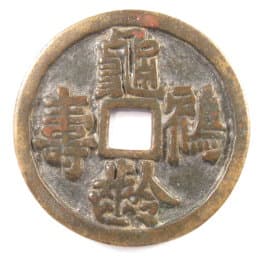 The subject of this old charm is
longevity and I consider it to be one of the most
beautiful in my collection. The calligraphy is
outstanding. The quality of the metal and the
casting are also superb.
The subject of this old charm is
longevity and I consider it to be one of the most
beautiful in my collection. The calligraphy is
outstanding. The quality of the metal and the
casting are also superb.The four character inscription is read top to bottom and right to left as gui ling he shou (龟龄鹤寿) which translates as "live as long as the tortoise and the crane". Both the tortoise and the crane are symbols of longevity.
While this charm does not actually display images of a tortoise and crane, there is some historical evidence that the very first depictions of a tortoise and crane together to signify longevity occurred on charms of the Six Dynasties (220 - 589 AD) which had the inscription "live as long as the tortoise and the crane".
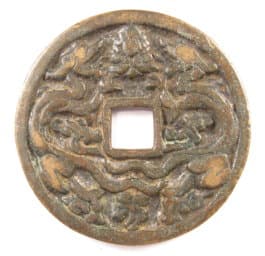
The reverse side shows a pair of dragons, one on each side of the square hole. Between their heads at the top of the piece is a pearl.
The diameter is 51 mm and the thickness is 3.5 mm.
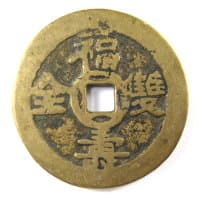
This is another old charm which has seen much use over many years.
The obverse side has the inscription fu shou shuang quan (福寿 双 全) which means "happiness and longevity both complete".
Both the obverse and reverse sides have a circular border surrounding the square hole. This symbolizes "wealth" because it is the traditional shape of the Chinese cash coin which is round with a square hole in the center.
There is also another level of meaning here. The ancient Chinese believed that the sky (heavens) was circular and the earth was square. For a further discussion, please see the Book of Changes (I Ching) and Bagua Charms.
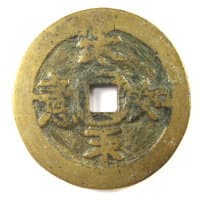
The reverse side of the charm also shows quite a degree of wear.
The inscription reads tai ping ru yi (太平如意) which translates as "may you have peace according to your wishes."
The diameter of the charm is 41 mm and the weight is 25.5 grams.
Return to Ancient Chinese Charms and Coins